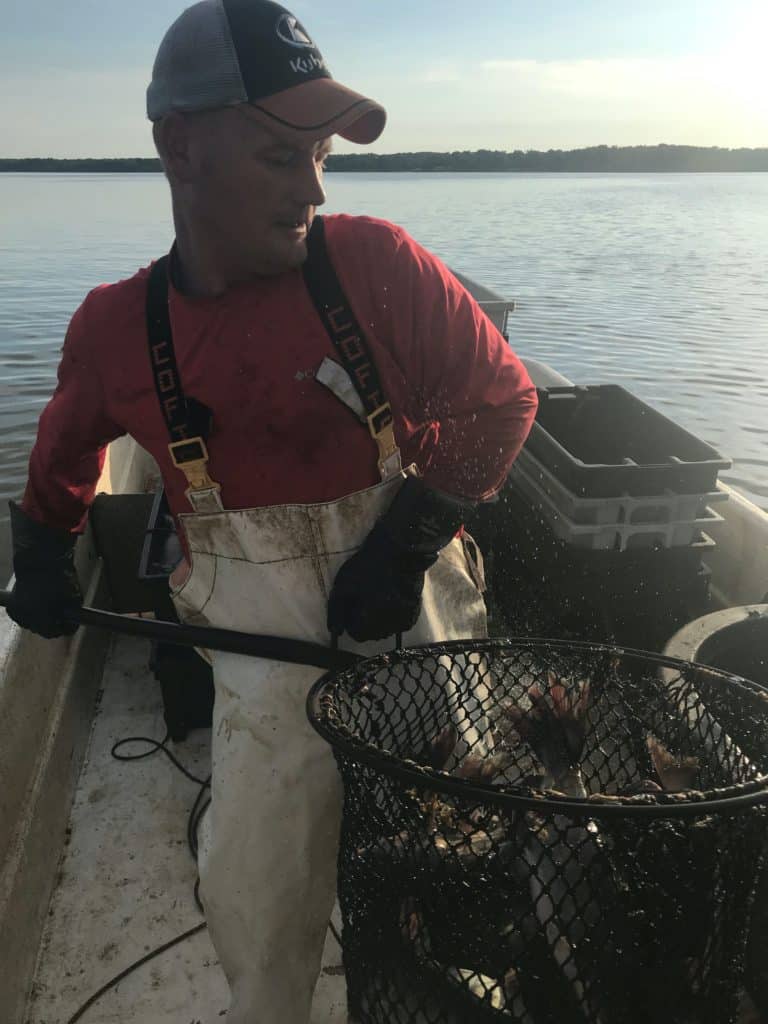Boosting Potential for Chesapeake Bay Blue Catfish

By Brenda Wintrode
For over a decade, Maryland officials have attempted to increase public demand for the booming population of invasive blue catfish in the Chesapeake Bay. The largest of the North American catfish enjoys dining on the Bay’s bounty of blue crabs, menhaden, herring and shad, making seafood industry stakeholders eager to catch them. While the number of pounds of blue catfish sold nearly tripled between 2015 and 2018, according to the Maryland Department of Agriculture, government officials and commercial seafood processors say regulations and perceptions still block the market from reaching its full potential.
“You really have to give it a nice story, to a chef or to someone, because they’re going to say, ‘Listen, my customers here are not going to order catfish from the menu. Because they always associate it with channel catfish,” said Stephanie Pazzaglia, business development manager for processor and distributor J.J. McDonnell and Co.
Pazzaglia said once chefs and stores hear the wild-caught blue catfish is sustainable and invasive, as opposed to its farm-raised cousin, it’s often a story they want to share with their customers. And it’s a story many state agencies are also telling to as many potential blue catfish customers as will listen.
Current federal regulations limit the quantity of blue catfish that can be processed, industry stakeholders say. U.S. Department of Agriculture inspectors must be present to accurately label catfish species, channel catfish versus Vietnamese, for example. And watermen must bring in blue catfish during the federal inspector’s 8-hour, Monday-through-Friday shift.
Pazzaglia said alleviating the time limitations on inspections, even for a large processing plant like hers which has an on-site inspector, would allow them to process more fish at night and on weekends. Currently, if they need an extension of the inspector’s hours, beyond their eight-hour shift, the processor would have had to request it the day before. The increase in volume would expand available supply to states where eating from sustainable sources aligns with consumer values, Pazzaglia said. “We’re working with a lot of different national opportunities where we can sell blue catfish in high volume, to California or to Washington or Colorado,” she said. “The more blue catfish we can move, the more we can get out of the Bay.”
Joe Love, freshwater fisheries program manager for the Maryland DNR, assists in educating watermen on the availability of blue catfish in the Bay and pitching the mild-tasting, flaky, white fish to vendors, like grocery stores. His efforts are motivated by the mission to protect the natural resources of the Bay.“If consumers want to buy the product, vendors will want to sell it more,” Love said. Increasing demand will perhaps lead to better prices for watermen, he said.
According to the Chesapeake Bay Program, blue catfish, native to the Mississippi, Ohio and Missouri River basins, were introduced into Virginia rivers in the 1970s as a sport fish and have few regional predators. While the freshwater-loving fish also do well in brackish environments, record 2018 rainfalls in the Bay watershed created even more hospitable conditions.
Last year, an estimated 5 million to 7 million pounds of blue catfish were caught commercially in Maryland and Virginia, according to Martin Gary of the Potomac River Fisheries Commission. Gary said over 2.4 million pounds were reported to the PRFC alone. “Right now, if you go out fishing recreationally or commercially, probably 96 percent of what you’re going to catch are blue catfish. That’s how dominant they are,” Gary said.
Newburg waterman Rocky Rice says he’s now making a living off of blue catfish. The species makes up 80 to 90 percent of his annual fish harvest. “I make more money off catfish than I do hard crabs,” said Rice. He began fishing for catfish in 2013 when his other harvests like crabs were having an off year. Now he says he’s making an income while also helping to balance the Bay’s ecosystem.
“We don’t want them to destroy habitat for rockfish and other species that have always been here, but at the same time, it’s a very good marketable product,” Rice said. “And a lot of people are paying and making a living off of them.”
